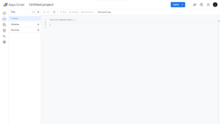 | |
| Developer(s) | |
|---|---|
| Initial release | August 19, 2009[1] |
| Written in | JavaScript |
| Type | Web application framework, scripting framework |
| Website | script |
Google Apps Script is a scripting platform developed by Google for light-weight application development in the Google Workspace platform. Google Apps Script was initially developed by Mike Harm as a side project while working as a developer on Google Sheets.[2]
The primary function of Google Apps Script is to facilitate the creation of custom tools for organizations, primarily focusing on automating tasks and simplifying system administration processes. It supports a community-based model for user support.
Google Apps Script was first publicly announced in May 2009 when a beta testing program was announced by Jonathan Rochelle, then Product Manager for Google Docs.[3] In August 2009, Google Apps Script was subsequently made available to all Google Apps Premier and Education Edition customers.[4]
YouTube Encyclopedic
-
1/5Views:427 407349 196411 19674 8244 478
-
What is Google Apps Script?
-
Google Apps Script Tutorial for Beginners
-
What is Google Apps Script?
-
Google Apps Script - Get and Set Values on Google Sheets
-
Why Google Apps Script is recommended by Martin Hawksey (pt.1)
Transcription
Google Apps Script is a cloud-based development platform for creating web applications. With just a browser, you can build scalable web applications that integrate easily with Google products. Apps Script uses a familiar JavaScript format. So you can take what you know about web development and what you know about Google products and create something new really quick. Google APIs and user interface tools are built right into Apps Script as services. And the script editor gives you fast access to all the services with code completion. Accustomed to editing HTML? There's an HTML service you can use to make templates and layouts. And with the same library of services, you can save data in Google Spreadsheets, connect to external databases, or use the new ScriptDb to create a JavaScript object store. When you're ready to share your web application, publish it as its own service with versioning and shareable libraries. Apps Script even has quick publishing to the Chrome Web Store, where anyone can find, install, and use your web application. To create a new script project of your own, open Google Drive, and click Create, More, Script. Or just go to script.google.com to start your first project today.
Technical details
Until 2020, Google Apps Script was based on Mozilla's Rhino JavaScript (JS) interpreter, which limited its JS language support to version 1.6, with a subset of the ECMAScript 5 API.[5] In March 2020, Google announced the introduction of the V8 JS runtime, bringing with it full support of modern ECMAScript except for JS modules.[6]
The development environment for Google Apps Script is hosted in the cloud, with an IDE with a debugger for developing scripts directly within a web browser.The infrastructure provided by Google serves as the execution environment for Apps Script projects. This platform enables the automation of tasks across Google services and integration with third-party applications.[7] Additionally, Google Apps Script facilitates the development of add-ons for Google Docs, Sheets, and Slides, enhancing their functionality.[8]
Limitations
Google Apps Script has some processing limitations. As a cloud-based service, Apps Script limits the time that a user's script may run, as well as limiting access to Google services.[9] Currently, the Google Apps Store does not allow direct connections to internal (behind-the-firewall) corporate databases, which is key to building business apps. However, this can be overcome via the use of the JDBC service if connections are allowed from Google servers to the internal database server.[10] Similarly, lack of other connectivity, such as LDAP connectivity, limits the level to which GAS can be used in the enterprise.[citation needed] Due to the cloud nature of Apps Script, functions related to date and time will produce results that seem to be incorrect due to the data crossing time zones. Using Date/Time objects and functions without very precise declaration and thorough testing may result in inaccurate results.[11]
Add-ons
In March 2014, Google introduced add-ons for Docs and Sheets (soon followed by Forms). The add-on stores let users add extra features to Google editors, such as mail-merging, workflows, and diagram builders. All add-ons are either 100% built with Apps Script or simply use Apps Script to display a UI in the Google editors while relying on an external back-end to perform some tasks. For example, MailChimp, a mail-merging tool, has an add-on for Google Docs that communicates with MailChimp platform to send emails.
Before add-ons, it was possible to publish scripts for Google Sheets in the Script Gallery. When users installed scripts through this gallery, a copy of the Apps Script code was installed on the user's Sheet. With add-ons, the source code is not visible to the end user, and everyone is using the latest version published by the developer. This new approach makes it easier to support existing code and helped convince several companies, such as MailChimp or Lucidchart to invest in Apps Script.
As part of the add-ons release, Google also introduced a UI Style Guide[12] and CSS package to help developers build add-ons that integrate into the editors. Each add-on is also reviewed by Google before its publication, and developers can benefit from advice from Googlers to provide a better user experience. It is not possible to embed ads in add-ons but it is possible to monetize them.[13]
See also
References
- ^ Meyer, David (August 20, 2009). "Google Apps Script gets green light". CNet. Retrieved 26 March 2011.
- ^ Koleda, Eric (August 21, 2019). "Celebrating 10 years of Apps Script: looking back on how it started". Google Cloud Blog. Retrieved 22 August 2019.
- ^ Rochelle, Jonathan (May 27, 2009). "Old tool, new tricks". Google Cloud Blog. Retrieved 22 August 2019.
- ^ Levey, Evin (August 19, 2009). "Google Apps Script Launched to Google Apps Premier and Education". Google Apps Script. Retrieved 22 August 2019.
- ^ Kienle, Holger (May–June 2010). "It's About Time to Take JavaScript (More) Seriously". IEEE Software. 27 (3): 60–62. doi:10.1109/MS.2010.76. S2CID 11650861. Archived from the original on 29 June 2010. Retrieved 25 March 2011.
- ^ "Apps Script's new V8 runtime".
- ^ Google Apps Script
- ^ Bring a little something extra to Docs and Sheets with add-ons
- ^ "Quotas for Google Services | Apps Script".
- ^ "JDBC | Apps Script".
- ^ "Issue 1035: utilities.formatdate subtracts a day". Retrieved 17 December 2012.
- ^ UI Style Guide for Add-ons
- ^ "I've started a little experiment..." Archived from the original on 2017-02-26. Retrieved 2014-11-18.

